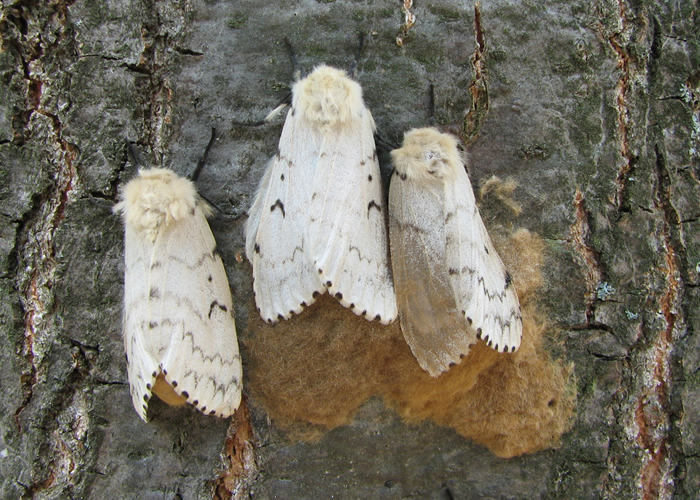July 3rd, 2015
Eww! Gypsy Moths are spreading their wings, having sex and laying eggs for next year!

So we've made it though the munching, pooping gypsy moth larva (caterpillar) phase of early summer. Go ahead. Sweep up the shredded leaves and poop, scrub the deck and patio furniture and enjoy the outdoors again.
While you can breathe a sigh of relief that your outdoor beverage of choice is less likely to get shit in than it would have three weeks go, the destructive caterpillars are fulfilling their destiny by shedding their cocoon, spreading their wings and taking flight.
Which is the male and which is the female?
Identifying gypsy moth gender is easy. White moths are female, brown moths are male.
White female moths don't fly. They hide at the base of trees, limbs, rocks, leaves, etc… emit sex pheromones to attract males and wait for their prince charming to sweep them off their… hmmm, furry little legs.
Brown moths are male and like their human counterparts, they cruise around town looking for females... and if all goes well, (cue the Barry White), they get it on!
After a quick smoke and some spooning, females will lay their eggs in egg masses, furry little brown sacks attached to just about anything. Tree trunks, limbs, rocks, houses, under decks, etc... they're not too particular. These egg masses lay dormant over the winter and emerge as a new round of larva in the spring.
So what can property owners and tree hugging hippies do?
If you're concerned about another round of defoliation next year (as you should be) it's time to take to the backyards, woods, vacant lots and set gypsy moth traps, destroy egg masses, and do whatever it takes to help our forests recover from this year's devastation. Remember, 2-3 years of consecutive defoliation will kill a tree. We must work to stop that from happening.
Below are a handful of ways you can help protect your property from gypsy moths. Visit www.gypsymothalert.com for specific details.
- Duct tape and tanglefoot
- Burlap folded strips
- Burlap strips sprayed with insecticide
- Gypsy moth traps
- Search for and destroy egg masses
- Aid the spread of virus fatal to gypsy moths
- Encourage birds to visit your property
- Hire a professional exterminator to spray from the ground
So what can the town government do?
We need to encourage Vernon Township to contact NJ Department of Agriculture and insist they perform a tree damage and egg mass assessment in hopes that our area qualifies for an aerial spraying in the spring. Yes… there's a cost involved, but as a "4 Season Community" and ecotourism destination, the Appalachian Trail and "Scenic Byway" (aka route 515/94 Corridor) will be highly disappointing if you look up to find acres and acres of dead trees all along the ridge of Waywayanda Mountain not to mention our residential sections where curb appeal is important in attracting new residents to the area.
So get out there... set moth traps, search and destroy egg sacks and prepare for battle next year. Contact the Mayor & town council and let them know that we need their help to save the mountain!
Additional Resources
- Invasion of the Caterpillars - Advertiser News North
- Gypsy Moth Caterpillars Always a Nuisance - NJ Herald
- Identify Egg Masses (PDF) - University of Wisconsin
- Gypsy moths in the United States - Wikipedia

